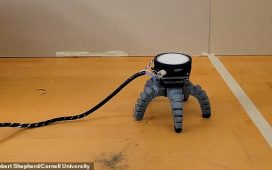Getting paid hundreds of thousands of pounds to eat as many hotdogs as you like may sound as close to a dream job as you could possibly get.
But in reality, competitive eating is closer to a nightmare.
This Monday, Netflix will host the long-awaited rematch between hotdog chomping legends Joey ‘Jaws’ Chestnut and Takeru Kobayashi.
As these two prepare to chow down on over 70 hotdogs in just 10 minutes, MailOnline spoke to scientists to understand exactly what it takes to become a champion competitive eater.
From excruciating stomach stretching training to the very risk of choking to death, this fast growing ‘sport’ is far from what it seems.

As long-time rivals Joey Chestnut and Takeru Kobayashi prepare for their hotdog-eating rematch, MailOnline takes a look at what it really takes to be a champion speed eater
What is competitive eating?
Competitive speed eating is pretty much as simple as it sounds.
While the specific rules vary depending on the food, challengers usually go head to head to see how many food items they can scarf down in a set time limit.
Competitions like The Nathan’s Famous International Hot Dog Eating Contest at Coney Island got started in the 1970s, but sprung to popularity in the early 2000s.
Since 2014, the annual hotdog eating contest has been broadcast by ESPN to huge audiences across the US.
The sudden interest in the ‘sport’ is partially due to a series of young competitors like Takeru Kobayashi, who pushed the limits of what was thought to be possible.
In his first appearance in the US in 2001, Kobayashi doubled the previous world record by eating 50 hotdogs in 12 minutes.
The event organisers were so surprised by Kobayashi’s performance that they ran out of signs to record the number of hotdogs eaten.
Driven by intense rivalries and ever-larger financial incentives, Kobayashi and Joey Chestnut have now pushed the record to seemingly superhuman levels.
Currently, the record set by Chestnut in 2016 stands at a truly unbelievable 76 hotdogs in 10 minutes.
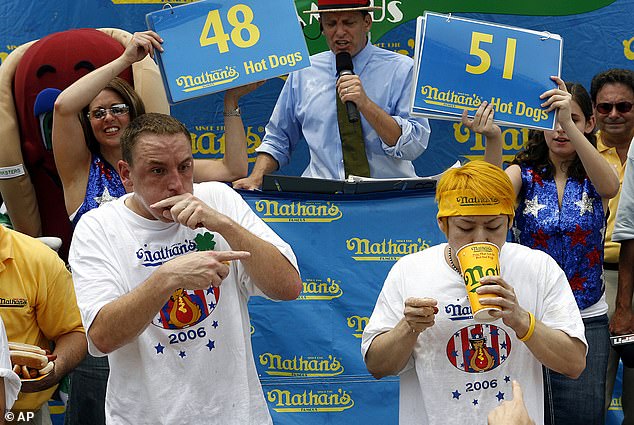
Joey Chestnut (left) and Takeru Kobayashi (right) have traded the world record for hotdog eating back and forth for almost two decades of competitions
The stomach of a champion
If you want to be a champion in the world of competitive eating, there are two key factors: how fast can you get food to your stomach, and how much your stomach can hold.
Normally, the human stomach is about the size of two fists put together and has a capacity of around a litre and a half.
During competitions, a speed eater’s stomach can balloon more than four times its normal size.
Professor Kathleen Melanson, an expert in appetite physiology from the University of Rhode Island, told MailOnline this is possible thanks to their abnormally stretchy stomachs.
Professor Melanson says: ‘Competitive eaters are not the norm, they tend to have a stomach elasticity that is at the extreme end of the spectrum.’
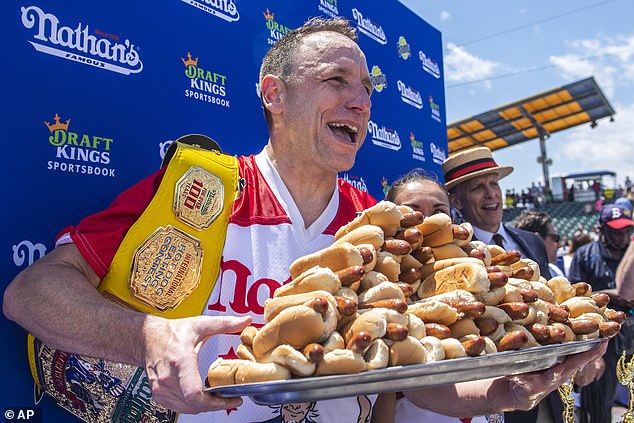
To eat up more than 70 hot dogs in a single sitting, competitive eaters like Joey Chestnut need to have stomachs with extreme levels of natural elasticity
Like any sporting competition, you’re not going to break any records without putting in some serious work – and competitive eating is no exception.
Their genetic dispositions might give them an edge but speed eaters also work hard to stretch their stomachs beyond the normal human limits.
As the stomach expands, stretch receptors in the surrounding muscles send signals to the satiating centres of the brain telling it it’s time to stop eating.
By enhancing their natural stomach elasticity through training, competitive eaters may be able to ‘turn down the dimmer switch’ on the satiety response.
In a study of a speed eater’s stomach published in 2007, Dr David Metz of the University of Pennsylvania described the changes this caused to the body.
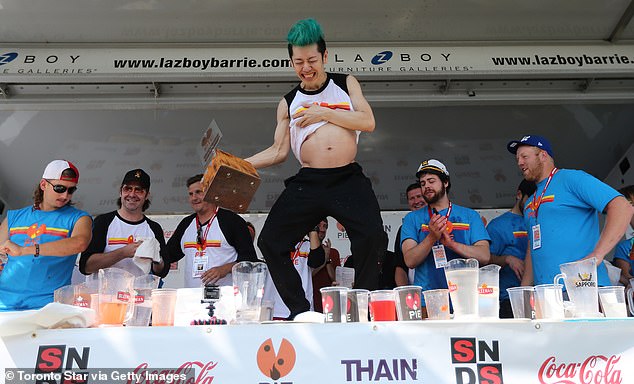
During a competition, a competitor’s stomach can stretch to more than four times its normal size to accommodate the food. In this photo, you can clearly see how distended Kobayashi’s stomach is after eating over 15lbs of pizza
Dr Metz wrote: ‘The speed eater had markedly altered gastric physiology that enabled his stomach to rapidly accommodate an enormous quantity of ingested food by progressively expanding until it became a giant, flaccid sac occupying most of his upper abdomen.
‘In other words, his stomach acted as a compliant, expansile receptacle, dilating to a degree that it could accept an almost unlimited volume of food.’
This is what allows competitive eaters to achieve incredible feats like consuming 9.22 litres of chilli, as Carmen Cincotti did to set the world record in 2018.
However, Dr Metz told MailOnline he is not sure whether an eater’s stomach is something that can be developed or if you need to be born with it.
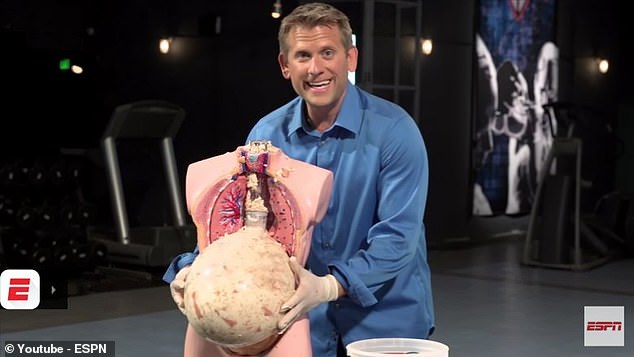
This model demonstrates what the stomach might look like after eating 69 hotdogs and buns
Many speed eaters ‘train’ by drinking vast quantities of liquids to force their stomachs to rapidly expand when needed.
For example, doughnut-eating champion Yasir Salem says he would drink 4.5 litres of juice in a minute every morning for a month prior to competing.
However, Professor Melanson points out that, while these techniques can be effective, training with water or other liquids can be extremely dangerous.
Drinking excessive quantities of water can lead to a condition called hyponatremia as the blood becomes so dilute that it overwhelms the kidneys.
Water then begins crossing into the cells including those in the brain, leading to kidney failure, heart failure, and potentially lethal brain swelling.
Dr Metz also points out that it is ‘unclear’ whether this training really helps, since it has never been scientifically studied.
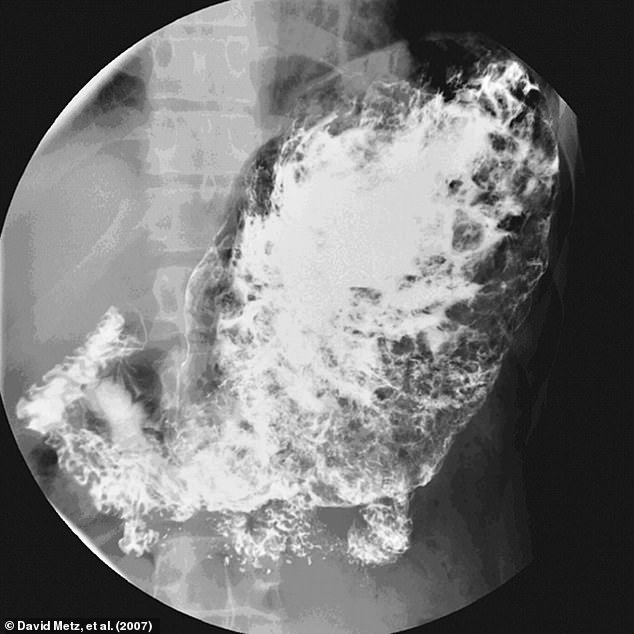
This x-ray shows a competitive eater’s stomach after consuming 36 hotdogs and buns. The study found that the stomach had become a ‘dilated, flaccid sac’ after years of training
Taking a bite out of the competition
When it comes to the sheer speed of consumption, speed eaters push the boundaries of how much food can physically be forced into the human body.
A research paper published in 2020 used 39 years of data from the annual Nathan’s Famous Hot Dog Eating Contest to estimate the theoretical limit for eating speed.
The researchers estimate that the ‘maximal active consumption rate’ is approximately 832 grams of fresh matter, or 8.32 hotdogs, per minute.
To put that in perspective, the researchers note that a grizzly bear’s maximal active consumption rate is only 798 grams, or 7.98 hotdogs, per minute.
With Joey Chestnut clocking in at 7.6 hot dogs per minute, elite human eaters are not only pushing the limits of human endurance but also giving bears a serious run for their money.
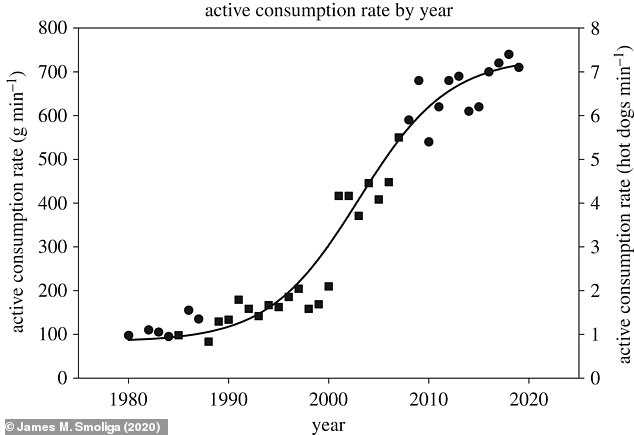
Researchers have used the last 39 years of hot dog eating competitions to calculate that the maximum possible rate of consumption is approximately 832 grams of fresh matter, or 8.32 hotdogs, per minute
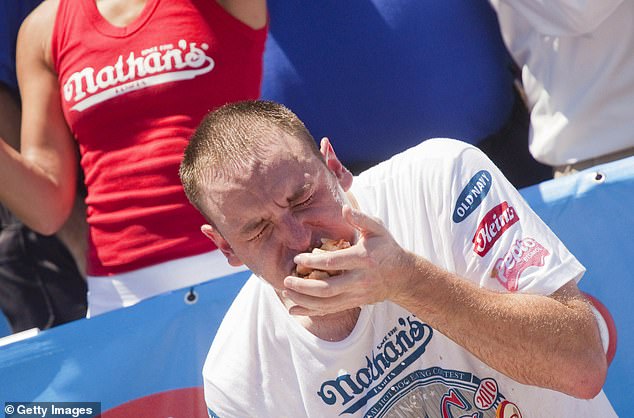
Hitting rates of 7.6 hotdogs per minute, Joey Chestnut has a consumption rate similar to that of a grizzly bear
But like any sporting competition, you’re not going to break any records without putting in some serious work.
The best competitive eaters use specialised techniques and rigorous training to give themselves the winning edge.
Kobayashi famously invented a manoeuvre he called the ‘Solomon method’ to achieve his record-breaking performances.
This technique involves tearing the hotdogs in half and dunking both halves in water to wet the bread before cramming both sides into your mouth.
In addition Kobayashi is known for his jumping and twisting techniques which use gravity to help force food through the oesophagus.
Competitive eaters will also train their ability to chew and swallow food by exercising their jaws and throat muscles.
Joey Chestnut’s workout routine involves chewing on a rubber ball and lifting weights with his teeth.

Takeru Kobayashi uses the ‘Solomon method’ which involves tearing hotdogs in half before dunking them in water
When ESPN tested his bite strength, it was found to be in excess of 127kg (280 lbs) – greater than that of a German Shepherd.
Speed eaters will practice swallowing full mouthfuls of water to train their throat muscles in order to take even bigger bites.
Naturally, trying to cram whole hotdogs down your throat just isn’t going to work for competitors with a strong gag reflex.
Since throwing up results in disqualification, vomiting, also known as the ‘reversal of fortune’, is a serious problem for top competitors.
For some speed eaters like Kobayashi, overcoming the urge to spew is as simple as staying focused and keeping his mind off the taste of the food.
Others have turned to biofeedback specialists for advice and actively work to de-train their reflexes.
Competitive eater Yasir Salem told Mental Floss: ‘A lot of the suppression training has to do with brushing my tongue really far back, every morning and night.
‘It’s part of my daily routine. I don’t even think about it anymore.’
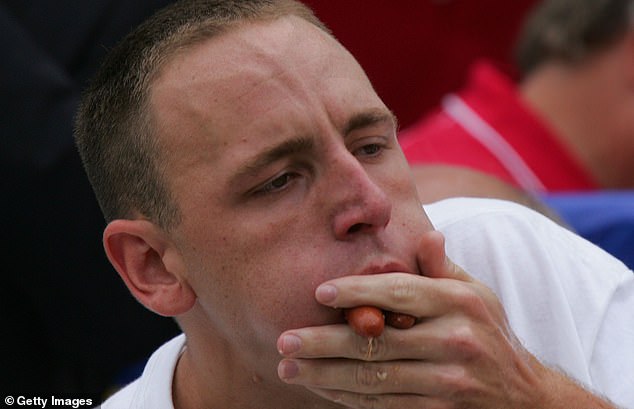
Joey Chestnut’s bite strength has been found to be in excess of 127kg (280 lbs), greater than that of a German Shepherd.
The fat belt theory
After regularly slamming 50-70 hotdogs in training you might expect competitive eaters to have piled on the pounds.
However, a look at the lineup of competitors reveals that this is far from the case.
Kobayashi has previously said that his ideal competition weight is just 60kg (132 lbs) and most professionals spend three to five days in the gym working to stay trim.
But this isn’t just a matter of personal aesthetics or even staying healthy.
Like everything else in the life of a champion competitive eater, getting trim is all about getting the winning edge.
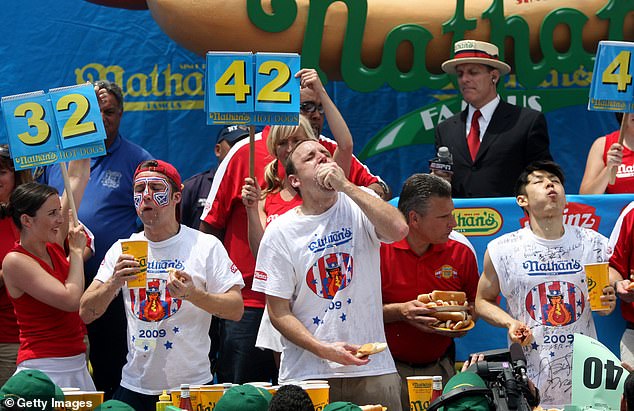
Contrary to what you might think, most serious competitive eaters tend to be thin and in good physical health. Many work out three to five days a week to stay in shape
Speed eaters believe that excess weight around the belly acts as a ‘fat belt’ which prevents their stomach from expanding as quickly as it might otherwise.
Just like a tight pair of trousers can be uncomfortable after Christmas dinner, the idea is that anything pressing on your stomach can lower its capacity and trigger the brain’s satiety response.
Professor Melanson says that there isn’t any scientific evidence for the theory but speed eaters have probably found this in their own experience.
Given that the majority of successful eaters are indeed very skinny, this hints that hitting the gym is likely an important part of the recipe for victory.
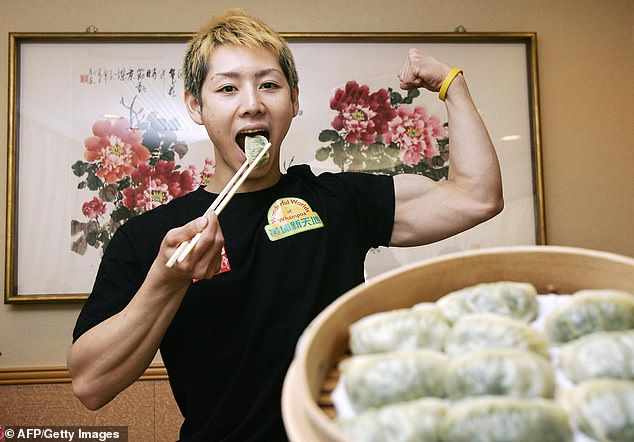
Kobayashi says his ideal competing weight is just 60kg (132 lbs) due to a belief that excess body weight acts as a ‘fat belt’ which restricts the stomach’s expansion
What are the risks?
Perhaps a little unsurprisingly, forcing 7 kg of meat and bread into your stomach in a 10-minute feeding frenzy can have some pretty dire consequences.
During competitions, eaters can actually consume so much that chunks of undigested food are forced out of the stomach and into the intestines.
As the sugar-rich food drops rapidly into the stomach, this can trigger something called dumping syndrome.
‘This is associated with heavy sweating and some gastrointestinal distress like diarrhoea,’ Professor Melanson explains.
Those chunks of food can also harbour colonies of bacteria leading to a condition called small intestinal bacterial overgrowth which, once again, leads to diarrhoea.
Of course, after all that food goes in it’s only natural to wonder how bad things must be when it has to come out.
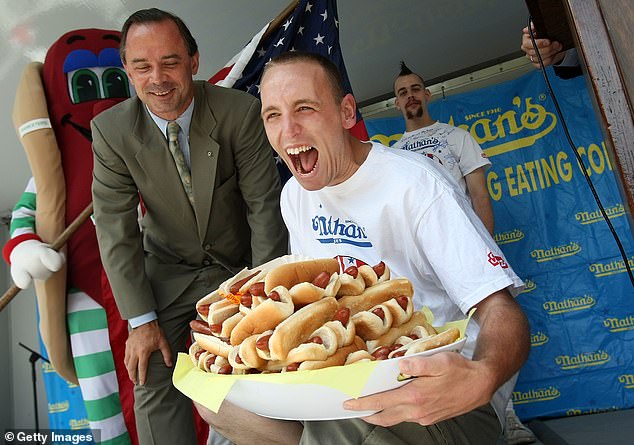
Eating over 7 kg of meat and bread in ten minutes can lead to health complications which range from the development of bacterial colonies in the small intestine to tears in the stomach lining
Although not many speed eaters have been forthcoming about these details, Peter Czerwinski, a professional eater known as Furious Pete has been very forthcoming.
Furious Pete told the Canadian Medical Journal Association: ‘There are only so many calories you can consume in 10 minutes, a lot of stuff goes through undigested.’
In a video posted to YouTube, Furious Pete further illustrated the issue, saying: ‘The toilet bowl gets full, and it gets to the point where it starts to overflow, and it just starts spewing out, and that becomes a little bit of a problem sometimes.’
However, compared to some of the possible medical consequences, an overflowing toilet bowl is getting off pretty lightly.
In 2019, a group of Singaporean medics described the case of a patient who had been hospitalised for five days after taking part in a competitive eating contest.
The patient had eaten a 3.2 kg burger in 30 minutes and had become gripped by intense pain when the burger refused to budge.
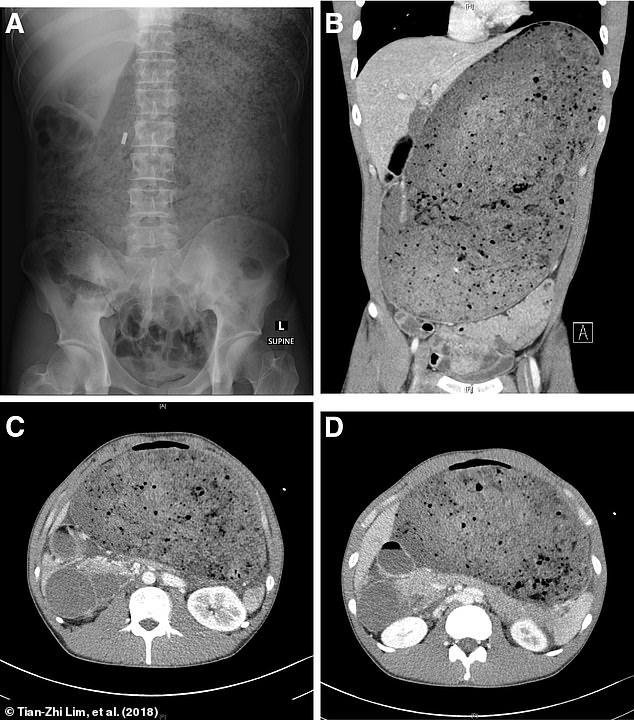
These X-rays show the stomach of a patient who was hospitalised for five days after eating a 3.2 kg burger in 30 minutes
The doctors were preparing for surgery to manually remove the undigested food before the patient ‘started to pass flatus’ and their condition improved.
Forcing so much matter into the body so quickly also creates a serious risk of tearing the stomach or oesophagus.
‘Some people have required surgery because it is just stretched so much,’ Professor Melanson says.
These injuries can even be fatal, as in the case of the Chinese streamer Pan Xiaoting who collapsed and died at 24 due to a suspected stomach tear incurred while eating.
However, the biggest issue of all is the extremely real danger of choking to death on the food or on your own vomit.
Since the year 2000, there have been at least six recorded deaths due to choking at speed eating contests.
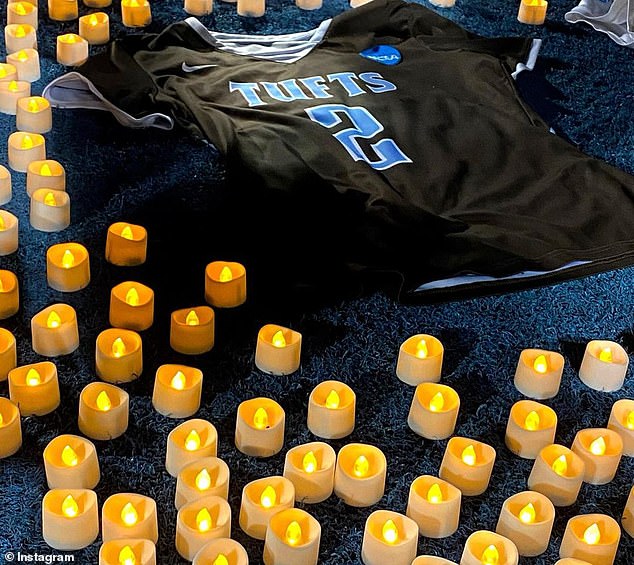
The biggest risk is that of choking which has led to a number of fatalities including the death of Madie Nicpon, a 20-year-old Tufts student who died in 2021. Pictured: Ms Nicpon’s shirt laid out at a vigil
This includes Madie Nicpon, a 20-year-old Tufts student, who died in 2021 after choking and falling unconscious during a hotdog eating contest.
Despite emergency services performing ‘extensive life-saving procedures’, the response was too slow to avoid a fatal injury.
Amateur events appear to be significantly more dangerous than those operated by the Major League Eating organisation since emergency services are less likely to be on standby.
This is especially problematic where speed eaters have deliberately de-trained the gag response which might put a check on dangerous consumption.
But even if eaters avoid the immediate dangers of the sport, the long-term effects could be severe and irreversible.
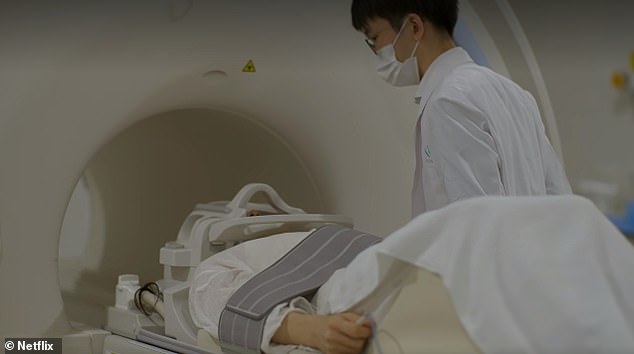
In Netflix’s documentary ‘Hack Your Health: The Secrets of Your Gut’ Kobayashi underwent an MRI (pictured) to determine what effect competitive eating has had on his brain and body. Experts warn that there is not enough evidence to determine the long-term risks
Kobayashi previously announced he would be retiring from the sport over concerns he was doing irreversible damage to his body.
In Netflix’s documentary ‘Hack Your Health – The Secrets of Your Gut’, Kobayashi described how he no longer feels any sensation of appetite or fullness.
‘I hear people say they’re hungry, and they look very happy after they’ve eaten. I’m jealous of those people because I no longer feel hunger,’ said Kobayashi.
What makes this so troubling, is that scientists simply do not know what the effects of years of competitive eating will be.
Professor Melanson adds: ‘One of the problems with speed eating is that there’s so few people on the planet who compete that there’s not much research funding.
‘Unless the research is done we don’t know [the consequences], but I would dare say that people who know they have a family history of cardiovascular disease or type 2 diabetes should not risk it.’




